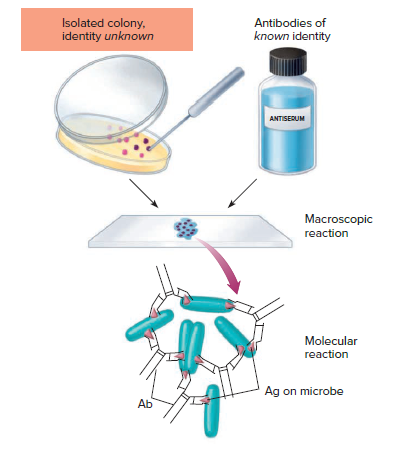
Concept explainers
From , figure Explain how this technique can be
used to diagnose infections with group A streptococci.

An immune response is the type of antibody production and activates in response to foreign antigen. In type III hypersensitivity, excessive production of immunoglobin IgG and IgM to a foreign or self‐antigen can lead to the development and accumulation of extreme amounts of insoluble intermediate‐sized immune complexes, which can be challenging to remove from various tissues by phagocytosis. This in turn may further, activate classical complement activation, leading to excessive production of other inflammatory mediators, activation and degranulation of peripheral blood granulocytes, such as basophils or an influx of neutrophils to particular tissues, such as the kidneys, lungs and joints culminating in damage.
Group A streptococci are extracellular bacterial pathogens that cause a variety of pyogenic infections affecting the mucous membranes, tonsils, skin, and deeper tissues, including, pneumonia, and meningitis. Infections could be mild to severe and may include multiple complications and even death.
Treatment of streptococcal toxic shock syndrome is possible with intravenous immunoglobulin (IVIG)that decreases the death rate. The reason could be that IVIG produces neutralizing antibodies. All three streptococcal pyrogenic exotoxins, A, B, and C, were inhibited by the IVIG.
Step by stepSolved in 3 steps

- describe an appropriate and most popular method for viral detection (quick and reliable) that could be adopted at the microbiology laboratory of the North-West University for detection of COVID19 infection.arrow_forwardCompare and contrast the advantages and limitations of phenotypic, immunologic, and genotypic microbial identification methods.arrow_forwardList the strategies commonly used to prevent and treat staphylococcalinfections.arrow_forward
 Human Anatomy & Physiology (11th Edition)BiologyISBN:9780134580999Author:Elaine N. Marieb, Katja N. HoehnPublisher:PEARSON
Human Anatomy & Physiology (11th Edition)BiologyISBN:9780134580999Author:Elaine N. Marieb, Katja N. HoehnPublisher:PEARSON Biology 2eBiologyISBN:9781947172517Author:Matthew Douglas, Jung Choi, Mary Ann ClarkPublisher:OpenStax
Biology 2eBiologyISBN:9781947172517Author:Matthew Douglas, Jung Choi, Mary Ann ClarkPublisher:OpenStax Anatomy & PhysiologyBiologyISBN:9781259398629Author:McKinley, Michael P., O'loughlin, Valerie Dean, Bidle, Theresa StouterPublisher:Mcgraw Hill Education,
Anatomy & PhysiologyBiologyISBN:9781259398629Author:McKinley, Michael P., O'loughlin, Valerie Dean, Bidle, Theresa StouterPublisher:Mcgraw Hill Education, Molecular Biology of the Cell (Sixth Edition)BiologyISBN:9780815344322Author:Bruce Alberts, Alexander D. Johnson, Julian Lewis, David Morgan, Martin Raff, Keith Roberts, Peter WalterPublisher:W. W. Norton & Company
Molecular Biology of the Cell (Sixth Edition)BiologyISBN:9780815344322Author:Bruce Alberts, Alexander D. Johnson, Julian Lewis, David Morgan, Martin Raff, Keith Roberts, Peter WalterPublisher:W. W. Norton & Company Laboratory Manual For Human Anatomy & PhysiologyBiologyISBN:9781260159363Author:Martin, Terry R., Prentice-craver, CynthiaPublisher:McGraw-Hill Publishing Co.
Laboratory Manual For Human Anatomy & PhysiologyBiologyISBN:9781260159363Author:Martin, Terry R., Prentice-craver, CynthiaPublisher:McGraw-Hill Publishing Co. Inquiry Into Life (16th Edition)BiologyISBN:9781260231700Author:Sylvia S. Mader, Michael WindelspechtPublisher:McGraw Hill Education
Inquiry Into Life (16th Edition)BiologyISBN:9781260231700Author:Sylvia S. Mader, Michael WindelspechtPublisher:McGraw Hill Education





